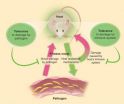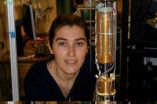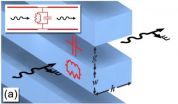(Press-News.org) The debate about the potential severity of an outbreak of airborne H5N1 influenza in humans needs to move on from speculation and focus instead on how we can safely continue H5N1 research and share the results among researchers, according to a commentary to be published in mBio®, the online open-access journal of the American Society for Microbiology, on Friday, February 24.
H5N1 influenza has been at the center of heated discussions in science and policy circles since the U.S. National Science Advisory Board for Biosecurity (NSABB) asked the authors of two recent H5N1 investigations and the scientific journals that planned to publish the studies to withhold crucial details of the research in the interest of biosecurity.
In the mBio® commentary, Michael Osterholm* and Nicholas Kelley, of the Center for Infectious Disease Research and Policy at the University of Minnesota, present their case that H5N1 is a very dangerous virus, based on their analysis of published studies of the seroepidemiology of H5N1 in humans. H5N1 flu infections have exceedingly high mortality, they say, and current vaccines and antiviral drugs will not pull us out of a global H5N1 pandemic. "We believe that the assertion that the case-fatality rate of H5N1 influenza in humans may be overestimated is based on a flawed data analysis," Osterholm said.
Analysis of reports of H5N1 seroprevalence that include data from the 1997 Hong Kong outbreak as well as data from 2004 to date will give a misleading impression because the 1997 outbreak was a very different "biologic event" that is recognized as such by the WHO, because the 1997 H5N1 virus has a significantly different genotype from that of later H5N1 viruses. This is why the WHO does not include the Hong Kong H5N1 virus data in any analysis of H5N1 transmission, and the 1997 Hong Kong virus is not recommended for inclusion in H5N1 vaccines, Osterholm explained.
Seroepidemiologic studies that have examined the exposure of various groups of people to H5N1 viruses only from 2004 onward indicate that only a small segment of the population has ever been exposed to H5N1, and that among those that have been exposed, many become seriously ill or die.
"The available seroepidemiologic data for human H5N1 infection support the current WHO reported case-fatality rates of 30% to 80%," Osterholm says. In the event of an H5N1 pandemic, they point out, if the virus is even one tenth or one twentieth as virulent as has been documented in these smaller outbreaks, the resulting fatality rate would be worse than in the 1918 pandemic, in which 2% of infected individuals died.
Vaccines will not head off an H5N1 pandemic either, the authors say, since the time required to develop and manufacture an influenza vaccine specific to new outbreak strain has resulted in "too little, too late" vaccine responses for the 1957, 1968, and 2009 influenza pandemics, and not much in the process has changed since 2009.
"The technology behind our current influenza vaccines is simply not sufficient to address the complex challenges associated with an influenza pandemic in the 21st century," Osterholm and Kelley say.
This is the heart of the matter, they say: there has been enough discussion about how severe an H5N1 pandemic might be. Moving forward, the current controversy has provided a valuable opportunity for scientists and public policy experts to discuss influenza research and preparedness and create "a roadmap for the future." The discussion among scientists and policy makers needs to move on from whether H5N1 poses a serious international threat - as it clearly does - and begin discussing how we can prevent these viruses from escaping labs and how scientists can share their flu-related results with those who have a need to know.
There are critical questions that need to be answered, the authors say. For instance, how can scientists conduct virus-transmission studies in mammals safely and how can scientists share research methods and results with those who have a need to know? We also need to come to agreement on how to ensure that strains of H5N1 viruses created in the lab don't escape those controlled environments, the authors say. And new, more effective vaccine technologies are needed that can enable substantially faster production. Resolving these issues could allow H5N1 research and preparedness to serve as a springboard for solving similar problems with existing or emerging pathogens.
###
*Michael Osterholm is a member of the National Science Advisory Board for Biosecurity.
Opinion: H5N1 flu is just as dangerous as feared, now requires action
2012-02-24
ELSE PRESS RELEASES FROM THIS DATE:
New strategies for treatment of infectious diseases
2012-02-24
The immune system protects from infections by detecting and eliminating invading pathogens. These two strategies form the basis of conventional clinical approaches in the fight against infectious diseases. In the latest issue of the journal Science, Miguel Soares from the Instituto Gulbenkian de Ciência (Portugal) together with Ruslan Medzhitov from Yale University School of Medicine and David Schneider from Stanford University propose that a third strategy needs to be considered: tolerance to infection, whereby the infected host protects itself from infection by reducing ...
Seat Belts in Bus Weren't Enough to Save 11-Year-Old in Fatal School Bus Accident
2012-02-24
A deadly school bus collision took the life of an 11-year-old girl and seriously injured 17 others, including both drivers. The girl who was fatally injured when a dump truck collided with the school bus in New Jersey was a triplet and her two sisters were both critically injured in the collision.
It's unclear what caused the crash at the intersection of Bordentown-Chesterfield and Old York roads in Chesterfield Township. The intersection has been the site of 15 accidents since 2007. The Huffington Post reported than another minor accident occurred the day after the ...
Fatal Accident Spurs Lawsuit, Painting Vivid Example of Legal Liability
2012-02-24
Tragedy Strikes in an Illinois Park
Last spring, a strange accident took the life of an Illinois man. Derek Posey and two coworkers were taking a break from their community service park work in a unique place: the bucket of an Illinois Department of Natural Resources construction tractor.
Unbeknownst to Posey and his compatriots, disaster was about to strike. A car driven by 20-year-old Eduardo Lopez careened into the parking lot. Later found to be under the influence of cannabis and methamphetamine, Lopez slammed into the tractor containing the workers.
All three ...
UC Santa Barbara researcher's new study may lead to MRIs on a nanoscale
2012-02-24
(Santa Barbara, Calif.) –– Magnetic resonance imaging (MRI) on the nanoscale and the ever-elusive quantum computer are among the advancements edging closer toward the realm of possibility, and a new study co-authored by a UC Santa Barbara researcher may give both an extra nudge. The findings appear today in Science Express, an online version of the journal Science.
Ania Bleszynski Jayich, an assistant professor of physics who joined the UCSB faculty in 2010, spent a year at Harvard working on an experiment that coupled nitrogen-vacancy centers in diamond to nanomechanical ...
New York Civil Rights Violation Lawyer from The Perecman Firm Comments on NYPD Killing of Unarmed Teen
2012-02-24
The funeral service of 18-year-old Ramarley Graham was held at a Bronx church on Saturday, reported WNYC (2/18/2012). The Bronx teen was gunned down by police inside his home in early February.
New York civil rights violation lawyer David Perecman agrees with a number of mourners that the killing appeared to be unjustified.
According to the New York Daily News (2/18/2012), Graham was killed by an officer from the NYPD's narcotics unit who believed he spotted a gun in Graham's waistband and followed him to his family's apartment. Graham was shot in the bathroom after ...
Mechanism behind capacitor's high-speed energy storage discovered
2012-02-24
Researchers at North Carolina State University have discovered the means by which a polymer known as PVDF enables capacitors to store and release large amounts of energy quickly. Their findings could lead to much more powerful and efficient electric cars.
Capacitors are like batteries in that they store and release energy. However, capacitors use separated electrical charges, rather than chemical reactions, to store energy. The charged particles enable energy to be stored and released very quickly. Imagine an electric vehicle that can accelerate from zero to 60 miles ...
New York Auto Accident Lawyer from The Perecman Firm Comments on Wrongful Death After Boy Killed When Driver Failed to Yield Right-of-Way
2012-02-24
A 6-year-old boy died in a two-car accident in upstate New York on Saturday night, reported The Wall Street Journal (2/19/2012).
Tyler McIntyre was killed when a 2008 Mercury failed to yield the right of way to another vehicle at an intersection in the town of Milton, said the YNN Hudson Valley (2/19/2012).
The boy died several hours after the upstate New York auto accident. The other people involved in the auto accident were treated for non-life threatening injuries and there was no indication alcohol was involved, according to the WSJ.
"Having an experienced ...
Penn researchers build first physical 'metatronic' circuit
2012-02-24
PHILADELPHIA -- The technological world of the 21st century owes a tremendous amount to advances in electrical engineering, specifically, the ability to finely control the flow of electrical charges using increasingly small and complicated circuits. And while those electrical advances continue to race ahead, researchers at the University of Pennsylvania are pushing circuitry forward in a different way, by replacing electricity with light.
"Looking at the success of electronics over the last century, I have always wondered why we should be limited to electric current in ...
SEAT Reveals the New Five Door Mii City Car
2012-02-24
SEAT is revealing an expansion to the Mii city car line-up with the first glimpse of an even more versatile five-door version.
The additional rear doors turn the super-compact SEAT into a unique combination of exceptional driving fun, sporty design and outstanding functionality.
Of course the new five-door Mii remains true to core SEAT principles - meaning it's both a pleasure to drive, and a pleasure to own.
In either three- or five-door form the Mii scores top marks for fuel consumption and emissions thanks to its lightweight design and efficient drivetrains. ...
Genome sequencing finds unknown cause of epilepsy
2012-02-24
Only 10 years ago, deciphering the genetic information from one individual in a matter of weeks to find a certain disease-causing genetic mutation would have been written off as science fiction.
It was the time of the Human Genome Project, and it had taken armies of sequencing robots working around the clock for almost a decade to unravel the complete sequence of the human genetic code – referred to as the genome – by churning out the DNA alphabet letter by letter.
Now a team headed by Michael Hammer from the University of Arizona applied Next Generation Genome Sequencing ...



